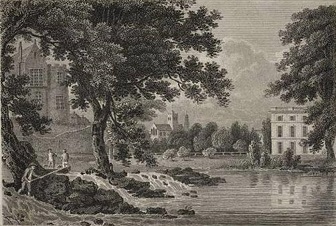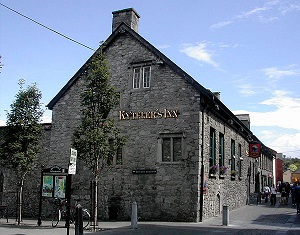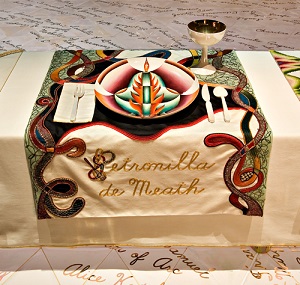Petronilla de Meath, Irish Witch
It’s a simple and somewhat sad fact that we really don’t know that much about Petronilla de Meath. We don’t know exactly when she was born (probably some time around 1300), nor do we know who her parents were or what they did. (We do know that they named their daughter after an obscure 2nd century Roman martyr – a grim omen of her future fate.) We don’t even know her real surname – “de Meath” just means “of Meath”, so if she had a family name then it’s been lost. (Her name is also occasionally spelled as “Petronella”.) She had a daughter, who might have been named Sarah, or maybe Basilia. We don’t know even know who her daughter’s father was. All we know then, is that she was probably born in Meath, and that she suffered and died for another woman’s supposed sins.

That “other woman” was Alice Kyteler, and Petronilla de Meath was unfortunate enough to be one of her servants. It was a misfortune that was shared by many others, as Alice was a very wealthy woman. She was born in Kilkenny in 1263, thirty-seven years before Petronilla. Her parents were Anglo-Normans of Flemish extraction. They weren’t noble, but rather they were from that buffer class that existed between nobility and the lower orders – the “landed gentry”. Alice was an only child, and so she inherited all of her family’s wealth – making her a very desirable marriage prospect. At the age of seventeen she married an equally wealthy man named William Outlaw. [1]
As will become clear throughout, our records from this time are often somewhat lacking. The pair had a son shortly after the wedding, who was named William after his father. William the Elder was Mayor of Kilkenny in 1301, and was a man of great influence. [2] But by 1302 Alice was a widow, and when she remarried the same year to Adam Blund tongues soon started wagging to claim that the pair had murdered William. There never seems to have been any serious investigation of this, and we know from later events that she stayed on friendly terms with William’s brother Roger. One source of the rumours could have been Adam’s children from a previous marriage, who were doubtless unhappy that their father was remarrying. But it’s likely that the rumours were motivated by simple dislike for the pair – understandable, as they both engaged in a trade certain to make the locals despise them. They were moneylenders.

The corrosive influence of moneylending on rural Irish communities is woefully under-documented. Few Irish writers (with the exception of Patrick MacGill) have tackled the subject, but it’s worth noting that the Irish word for moneylender (”gombeen”) is still used as an insult to this day. Whether Alice inherited it as a family trade, or whether she picked it up from her first or second husband, she soon became adept at chaining her tenants with debts and was widely hated by the common people throughout the area. In 1303 her son William Outlaw (who was by this time Mayor of Kilkennny) gave the portion of their fortune that he held in trust as £3,000 – the equivalent of tens of millions in today’s money. Tongues started wagging once again in 1307 when Adam Blund signed over all of his possessions to William, shortly before his death – effectively disinheriting his own children. In 1309 the forty-six year old widow married for the third time to a rich Tipperary man named Richard de Valle. By 1316 de Valle was dead and Alice was suing his son for her “widow’s dower” – a fancy way of saying she was entitled to a third of her dead husband’s property. She doesn’t seem to have been too devastated by the death as the same year she married husband number four, Sir Richard le Poer.
It would have been around this time that Petronilla de Meath entered into Alice’s service, though of course nobody bothered to record the events in the life of such an insignificant servant girl. Far more important were the the le Poer family (who would later go by other surnames such as Poore and Power). Sir Richard (who was a baronet) already had several grown children, and of course they weren’t very happy about his marriage to Alice. As a result they were already prejudiced against her, and when Sir Richard fell ill they immediately had their suspicions. Sir Richard himself said that he thought that somebody was poisoning him, though it’s unknown if he actually named his wife as the poisoner. That was enough for them, and they decided that Alice must be responsible. Poisons and such like being considered arcane knowledge at the time, that meant that in addition she must be guilty of witchcraft. When Sir Richard died in 1324, [2] they presented a case to the local bishop that Alice had killed him through poison and sorcery.

Nowadays the accusation of witchcraft may not seem unusual, as many such accusations were made throughout history. However at the time it was in fact practically unheard of. The witch trial mania that swept Europe wouldn’t arrive for another hundred years, and in fact the witch trial that their accusations would start is generally regarded as the first in history. However the idea of the witch was definitely something familiar to the Church, and Pope John XII had recently begun issuing announcements declaring the practice of witchcraft a dangerous heresy. He defined this in a book he would write in 1326:
They ask and receive responses from them and to fulfill their most depraved lusts ask them for aid. By doing any of this, they allay themselves with death and make a pact with hell.
It’s worth noting that the sentence he prescribed for these heretics was excommunication, though others felt sterner punishments were in order. One such was the bishop that the le Poers contacted – Richard de Ledrede, bishop of the diocese of Ossory. The natives of Ireland were generally given to folk practices and superstitions, which to the eyes of a Norman like de Ledrede looked suspiciously like witchcraft. Clearly these natives had corrupted Dame Alice, and she had taken up their practices. Convinced of the righteousness of his cause, Bishop de Ledrede immediately contacted the authorities to have her arrested. Their response was swift and decisive. They locked the bishop up.
The bishop had written to the Lord High Chancellor of Ireland accusing Alice, her son William, and a collection of her servants (including Petronilla) of heresy and witchcraft. However the Chancellor was in fact Sir Roger Utlagh, brother of Alice’s first husband and uncle of William junior. He didn’t want to see his sister in law in the hands of the bishop, so he instead joined with William to arrest the bishop. This allowed Alice to flee to Dublin where Sir Richard was able to protect her. The bishop was released after seventeen days, and began a series of high-profile confrontations with Sir Roger. This culminated in the bishop being summoned to Dublin to face charges for having excommunicated Alice without reason, but the bishop managed to convince the archbishop’s court of his case. Alice, wisely, fled Dublin. She escaped to England (and out of the pages of recorded history). William proved too influential to arrest outright, and the charges were dropped after he agreed to do penance for them. The bishop wasn’t left empty-handed though. He arrested ten people who had been accused along with Alice – including the unfortunate Petronilla and her daughter.

The trial began in June of 1324. In the absence of Dame Alice, Bishop de Ledrede had picked out Petronilla de Meath as the leader of the witches. Since no husband is listed for her in the records this may have been due to her being an unwed mother. The bishop had her repeatedly tortured through whipping, until eventually she broke down and confessed to the charges. Those charges (drawn from her delirium and the bishop’s vile imagination) were that she and the other witches had been consorting with demons, and specifically with one named “Robin, son of Art”. Robin sometimes took the form of a cat or a black dog, but most commonly appeared as a tall black-skinned man who would “have carnal knowledge” of Dame Alice. To gain the attention of these demons they had carried out sacrifices, and on the demonic advice they had created magical candles and ointments using:
the entrails of cocks sacrificed to demons, certain horrible worms, various unspecified herbs, dead men’s nails, the hair, brains, and shreds of the cerements of boys who were buried unbaptized, with other abominations, all of which they cooked, with various incantations, over a fire of oak-logs in a vessel made out of the skull of a decapitated thief.

Petronilla also confirmed the assertion of the children of Alice’s husbands that this magic had been used to ensorcel them, compel them to sign over their goods to Alice or to her son William, and then to kill them. Since at the time evidence gained under torture was considered valid in English law [3] this was enough to convict the unfortunate woman. After another round of public torture she was burned alive in Kilkenny on Sunday the third of November 1324. She was the first person in Irish history to be executed for the “crime” of heresy, though her trial and death were only a precursor of the many such deaths to come across Europe and America in the following centuries. [4]
Details are scant as to what happened to those accused alongside Petronilla, though it’s suggested that some were executed just as she had been while others were branded as heretics and imprisoned. [5] Emboldened by his success the bishop had the Seneschal of Kilkenny, who had tried to prevent him arresting Dame Alice, taken prisoner and transported to Dublin Castle as a heretic. However he soon learned that torturing and executing common peasants was one thing, but an attack on a public official was another. Bishop de Ledrede was thus himself accused of heresy and soon forced into exile, though he did eventually manage to return to his diocese. He died in 1360 and is buried in Kilkenny Cathedral.

The trial of Petronilla de Meath would go on to set the template for future witch trials, and the details of her “crimes” would be the inspiration for many more poor people to lose their lives. However even in Ireland few know that Kilkenny was the site of the first witch trial. What’s more, when the story is told it’s almost always as “the Trial of Dame Alice Kyteler”, with the actual victim, Petronilla, relegated to a footnote. Some accounts don’t even mention her at all. No monument to her death stands in Kilkenny, though a local pub operating in the house once owned by Dame Alice uses the Kyteler name to pull in the tourist trade. There is one exception to this, however. In 1979 the artist Judy Chicago created an installation piece called The Dinner Party. At this party are 39 women who Judy chose to represent all the women who have been been written out of history. The guests include some who have previously been covered in this column (such as Artemesia Gentillischi and Emily Dickinson). Among them a place has been set for Ireland’s forgotten martyr, Petronilla de Meath.
Images via wikimedia except where stated.
[1] The spelling of William’s surname is (as should be expected for the time) somewhat unclear. In his case it’s most often given as “Outlaw”, however as we’ll see later his brother is usually referred to in history books as “Utlagh”.
[2] Some records say that he survived and that he did join the accusations against his wife.
[3] This did change in the following century, with the result that the witch trial mania of later years claimed far fewer lives in England than it did in (for example) Scotland.
[4] Petronilla is the first recorded European victim of witch-burning. However in the 8th century (a more rational time when the church preached that witches didn’t exist) Charlemagne the Great ordered the death penalty for anyone convicted of having burned a supposed “striga”.
[5] Some accounts say that Petronilla’s daughter had been taken to England by Dame Alice, which ties into speculation (though there is no evidence) that Alice’s son William was the child’s father.
